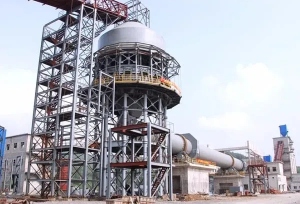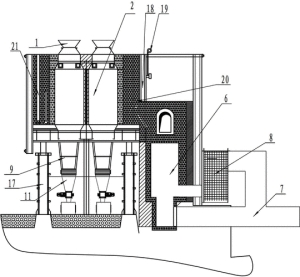【CPC】Factors Affecting CPC Quality in Concurrent Pot-type Calciners and Improvement Measures

【CPC】Factors Affecting the Quality of Calcined Petroleum Coke in Concurrent Pot-type Calciners and Improvement Measures
Pot-type calciners are essential equipment for carbon production, known for their advantages such as stable calcination quality, low oxidation loss of materials, high thermal efficiency, and the absence of external fuel requirements for delayed petroleum coke calcination. This article primarily explores the factors influencing the quality of calcined coke in pot-type calciners and summarizes the approaches to enhance the quality, providing insights for enterprises.

I. Factors Affecting Calcination Quality
The main objectives of calcination are to eliminate volatile components and moisture from raw materials, increase material density and mechanical strength, and improve electrical conductivity and chemical stability. To address the issue of varying calcination quality in different batches, it is crucial to analyze the factors affecting calcination quality and implement effective measures.
1) Raw Material Factors
Currently, delayed petroleum coke used in aluminum anode production in China often exhibits characteristics such as fine natural particle size, loose particle structure, unstable volatile content, and elevated trace element levels.
a. Particle size impact: Fine particle sizes of petroleum coke can lead to coke bed blockage during calciner operation, hindering the smooth release of volatiles, reducing combustion efficiency, and ultimately affecting calcined coke quality. Additionally, fine particle sizes result in higher calcination loss and lower yield, increasing operational costs.
b. Influence of volatile content: Volatile components generated during the calcination of petroleum coke are the primary fuel in calciners. Low volatile content can lead to insufficient fuel supply, reduced calcination temperature, insufficient calcination, and subsequent effects on calcined coke quality. Conversely, high volatile content can cause blockages in the calciner, making discharge difficult and even leading to excessive temperature in the combustion zone.
c. Impact of moisture content: Petroleum coke naturally contains some moisture, but excessive moisture can lower furnace temperature and lead to coke bed blockages in pot-type calciners.
d. Influence of trace elements: High sulfur content not only pollutes the environment and increases pressure on environmental protection facilities but can also lead to gas expansion, internal cracking of products, decreased coke block strength, and increased electrical resistance. Furthermore, elevated levels of vanadium, iron, silicon, and other elements can result in slagging and blockage in electrolytic cells, affecting aluminum purity.
2) Charging and Discharging Factors
In a pot-type calciner, materials are fed from the top and discharged from the bottom after calcination. Timely and appropriate charging and discharging ensure stable combustion of volatiles in the calciner, maintaining a consistent release of volatiles and minimal temperature fluctuations inside the calciner, thus guaranteeing stable calcined coke quality. Overloading, underloading, or delayed charging and discharging can lead to unstable volatile combustion in the calciner, causing fluctuations in calcination temperature and negatively impacting both calcined coke quality and calciner lifespan.
3) Calcination Temperature Factors
Calcination quality primarily depends on the calcination temperature and the duration of exposure to high temperatures. Insufficient calcination temperatures can result in inadequate coke shrinkage, leading to deformation or cracking of products. Conversely, excessively high calcination temperatures can reduce material density and mechanical strength. Therefore, maintaining an appropriate calcination temperature ensures material quality and prolongs the lifespan of calcination equipment. Based on production experience, the recommended calcination temperature for petroleum coke is generally between 1250-1380°C.
4) Calciner Wall Coking and Volatile Pathway Blockage Factors
During normal production, volatiles from the raw materials collect at the top exit of the calcination calciner and are introduced into various combustion zones through volatile distribution plates. Because the temperature of volatiles in these pathways is lower than in the combustion zones, tar deposits can form over time, leading to blockages. Similarly, as the overflow rate of volatiles increases in the calciner, coke bed blockages can develop above the first combustion zone and gradually harden, becoming difficult to manage. These blockages can obstruct the smooth entry of volatiles into the combustion zones, affect indirect heat transfer between the combustion zones and raw materials, lower the calcination temperature, and impact product quality.

II. Improvement Measures
1) Control of Raw Material Quality and Composition
Strict quality control of petroleum coke is essential to prevent fluctuations in calcined coke quality. Establish a rigorous quality management system where each batch of petroleum coke used in production undergoes sampling and comprehensive testing, including moisture content, ash content, volatile content, fixed carbon content, particle size distribution, trace elements, and more. Additionally, store petroleum coke from different manufacturers and batches separately with proper labeling to facilitate blending. Rational blending based on different ash content, trace element content, particle size, and volatile content, calculated through reasonable formulas, can stabilize both product physical and chemical properties and the normal operation of the calcination calciner, ensuring consistent yield and quality.
2) Automation Control of Charging and Discharging in calciners
Implement computer and PLC (Programmable Logic Controller) automation control systems for the charging and discharging systems of calciners to ensure timely and appropriate material loading. Transition from intermittent to continuous material discharge can reduce coke bed blockages in the calciner, as continuous material flow minimizes stagnation. Continuous discharge can be achieved using variable-frequency motors for speed adjustment, regulating calciner output by controlling motor speed.
3) Proper Control of Calcination Temperature
Calcination quality primarily depends on the calcination temperature, with the duration at high temperatures also playing a role. Maintain appropriate temperature control in the first, third, and eighth layers of the calciner. Volatile components in the calciner primarily enter through the first layer, and combustion mainly occurs from the first to the third layers. Controlling the temperature above 1200°C in the first layer and within the range of 1250-1380°C in the third layer ensures optimal raw material calcination quality. An ideal temperature for the eighth layer is around 1000-1100°C, promoting material cooling and reducing the high-temperature pressure on clay bricks and cooling water jackets at the bottom of the furnace, thus extending calciner lifespan.
4) Regular Cleaning of Calciner Wall Coking and Volatile Pathways
Establish a systematic cleaning regimen for volatile pathways and empty calciner cleaning. Adhere strictly to this regimen, conducting cleaning every 20 days for volatile pathways, overflow outlets, and lower combustion outlets to ensure unobstructed volatile flow. Perform calciner wall cleaning every two months to maintain a clean surface for optimal heat transfer.
Traditional empty calciner cleaning involves stopping material charging for all calciners, continuing material discharge until the first layer is reached, then halting discharge and opening all furnace access covers. Tar deposits are oxidized by air over time, after which they can be rapidly removed using tools. However, this method extends the cleaning time and may affect calcined coke quality.
Implementing a "group empty calciner cleaning" approach can reduce quality fluctuations. In this method, only one group of calciners (typically four) is emptied at a time. Once cleaning is complete, volatiles from adjacent combustion zones are directed into the empty calciners through dedicated pathways, rapidly raising the temperature to the required level. This cycle ensures that calcined coke quality remains unaffected. Learn more about calcination system knowledge, feel free to communicate with us at any time.
No related results found








0 Replies